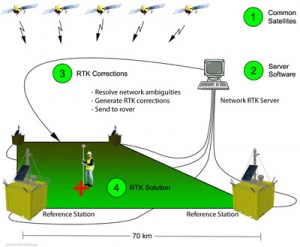If you wish to contribute or participate in the discussions about articles you are invited to contact the Editor
RTK Systems: Difference between revisions
Carlos.Lopez (talk | contribs) No edit summary |
|||
| Line 1: | Line 1: | ||
{{Article Infobox2 | {{Article Infobox2 | ||
|Category=Fundamentals | |Category=Fundamentals | ||
| | |Editors=GMV | ||
|Level=Basic | |Level=Basic | ||
|YearOfPublication=2011 | |YearOfPublication=2011 | ||
|Title={{PAGENAME}} | |Title={{PAGENAME}} | ||
}} | }} | ||
Revision as of 11:40, 23 February 2012
| Fundamentals | |
|---|---|
| Title | RTK Systems |
| Edited by | GMV |
| Level | Basic |
| Year of Publication | 2011 |
With origin dating back to the mid-1990s, Real Time Kinematics (RTK) is a differential GNSS technique which provides high positioning performance in the vicinity of a base station. The technique is based on the use of carrier measurements and the transmission of corrections from the base station, whose location is well known, to the rover, so that the main errors that drive the stand-alone positioning cancel out. A RTK base station covers a service area spreading about 10 or 20 kilometres, and a real time communication channel is needed connecting base and rover. RTK, which achieves performances in the range of a few centimetres, is a technique commonly used in surveying applications.[1][2][3]
There is a big amount of different receiver manufacturers including RTK in their products. With the purpose of solving the limitation that the rover needs to be at a range of a few kilometres from the base station, the technique has evolved from stand-alone base stations to RTK networks.
RTK Receiver Manufacturers
RTK is a ubiquitous technique used in geodetic receivers provided by manufacturers targeting the high precision market. In a product survey performed by the company Hydro International in the hydrographical field, the following RTK receiver brands were identified:[4]
- AD Navigation AS
- C&C Technologies
- Fugro
- Hemisphere GPS
- Leica Geosystems AG
- Magellan Navigation
- Septentrio NV
- Topcon Europe Positioning
- Trimble
It is noted that this is not an exhaustive list of RTK product providers, as some well-known manufacturers are missed, such as:
RTK Networks
In its origin, RTK was designed to broadcast corrections from one base station to a set of rovers in its vicinity. Due to the difficulties to fix the carrier phase ambiguities as the distance between base and rover increases, and to the spatial de-correlation of the errors corrected, the practical range of RTK is around 10 to 20 kilometres.[1]
In order to cope with this limitation, several standards have recently been developed to provide corrections for a network of base stations. In this way, the rover can use the nearest base station from the network without the need of reinitialising the ambiguity fixing filters. This is only possible if a common processing is done for the base stations, so that the carrier measurements broadcast for the different receivers in the network have consistent phase ambiguities.[1][5] RTK network solutions are particularly successful in regions with dense deployment of permanent base receivers, as it is the case in Europe.[5]
The list of standards that handle with RTK networks includes:
- RTMC v3.0[6] and higher versions.
- FKP[7] by Geo++.
- Virtual Reference Station (VRS) approach, property of Trimble. According to Trimble, VRS is the network solution used in more than 95% of the installations.[8]
Notes
References
- ^ a b c International Association of Geodesy (IAG) Working Group 4.5.1: Network RTK
- ^ RTK in Wikipedia
- ^ Remote Sensing 2009, A. Rietdorf et al., Precise Positioning in Real-Time using Navigation Satellites and Telecommunication, Proceedings of the 3rd Workshop on Positioning, Navigation and Communication (WPNC’06)
- ^ RTK DGPS Receivers, Product Survey, Hydro International, October 2007
- ^ a b Reference Station Network Information Distribution, by Hans-Jürgen Euler, IAG Working Group 4.5.1: Network RTK (2003-2007)
- ^ Radio Technical Commission for Maritime Services
- ^ On the modeling of GNSS observations for high−precision position determination, Gerhard Wübbena, Translation of Wübbena, G. (2001). Zur Modellierung von GNSS−Beobachtungen für die hochgenaue Positionsbestimmung. Wissenschaftliche Arbeiten Fachrichtung Vermessungswesen an der Universität Hannover, Festschrift Prof. G. Seeber zum 60. Geburtstag, Nr. 239, Hannover, 143−155.
- ^ Support of Network Formats by Trimble GPSNet Network RTK Solution, Trimble, 2005

